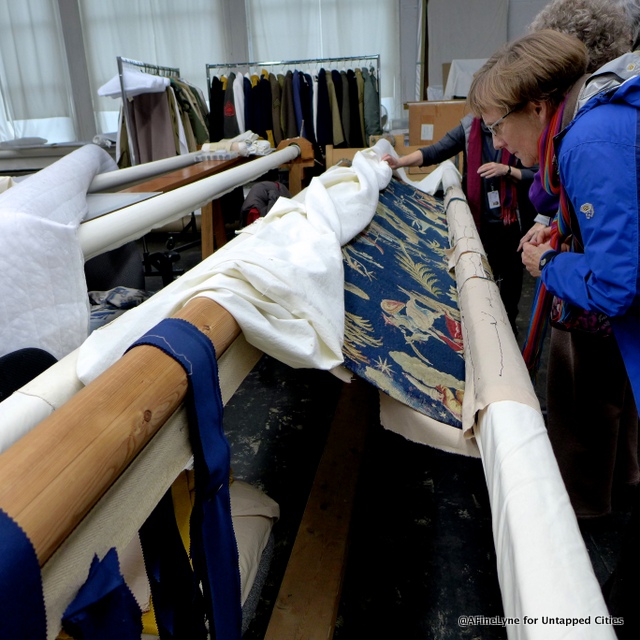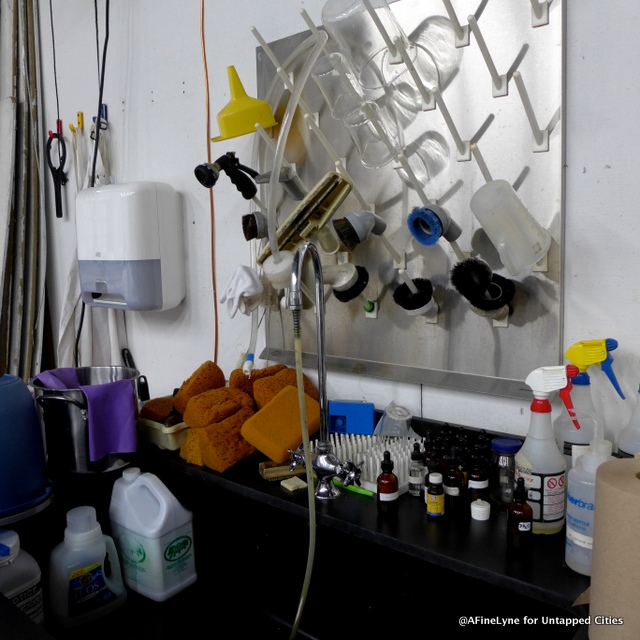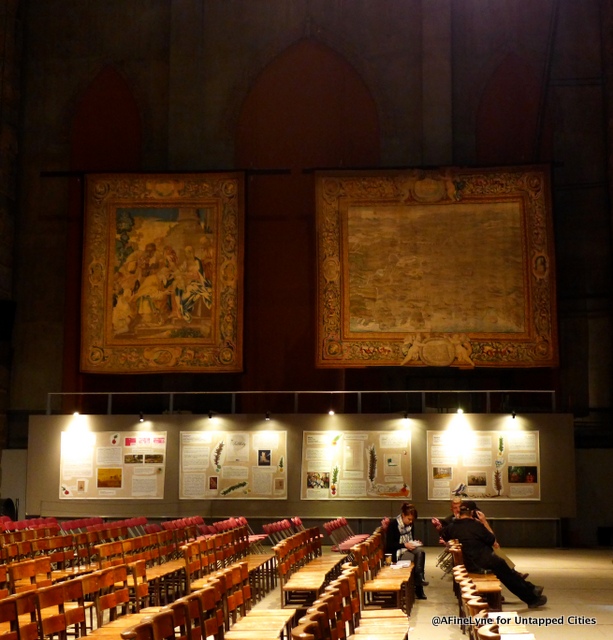 Currently on view in the Cathedral, Adoration of the Magi and The Map of the Holy Land
Currently on view in the Cathedral, Adoration of the Magi and The Map of the Holy Land
Follow the pathway between the Cathedral of Saint John the Divine and the Biblical Garden and you will find a Greek Revival building – the oldest existing structure in Morningside Heights. It is the home to the Cathedral’s Textile Conservation Laboratory. The Lab was established in 1981 to preserve the Cathedral’s collection of 17th century tapestries.
One year before construction began on the Cathedral in 1891, a donation of twelve 17th century Italian Barberini tapestries were purchased by a congregant, Mrs. Elizabeth U. Coles, and donated to the cathedral. The tapestries were acquired from a collector who purchased them from Italian Princess Barberini in 1889.
 A photo of the tapestry “Map of the Holy Land” kept in The Lab, used for the purposes of cleaning and restoration
A photo of the tapestry “Map of the Holy Land” kept in The Lab, used for the purposes of cleaning and restoration
In a handwritten note to the cathedral dated May 20, 1890, Mrs. Cole wrote “Dear Sir, Many many thanks for your very pleasant note respecting the Sacred Tapestries I have been able to procure for the adornment of the Cathedral of St. John the Divine. It gives me great pleasure that others share with me in the appreciation of the Tapestries.” The estimated value of the Barberinis tapestries in 1891 was $75,000 (Cathedral Archives). This set of Barberinis were originally woven under the direction of the nephew of the Barberini Pope, Uban VIII.
 Tapestries entitled “The Life of Christ” from the Barberini Collection
Tapestries entitled “The Life of Christ” from the Barberini Collection
In addition, the Cathedral has a collection of Raphael designed tapestries. These are woven from Flemish trained English loom operators, following ‘cartoons’ created by the artist Raphael. They depict scenes of the Acts of the Apostles drawn from the New Testament Book of Acts. Nine Mortlake tapestries were donated to the Cathedral by another congregant, Mrs. Margaret Louise Brugiere in honor of her late husband. She also donated an 18th century Flemish tapestry of unknown subject. They were gifted in 1954.
 A close-up of “The Life of Christ” giving keys to St. Peter from the Barberini Collection
A close-up of “The Life of Christ” giving keys to St. Peter from the Barberini Collection
Tapestries were often created as a way to depict scenes from the Bible and life as they knew it. The process is an intricate and time consuming one. It could take up to a year to complete a tapestry, with a couple of inches of hand weaving completed each day. As one of the most well known and well respected families of weavers, the House of Barberini benefited greatly with the uncle of Francesco Barberini as Pope. The family made tapestries for not only homes, but also for the Vatican.
 You will notice the Barberini signature of three Bee’s inside the circle, and the weaver’s signature in the lower right
You will notice the Barberini signature of three Bee’s inside the circle, and the weaver’s signature in the lower right
It became clear that with this large collection of treasured tapestries, the Cathedral would have to give thoughtful consideration to their care and cleaning. And so the Textile Conservation Laboratory opened its doors, with the primary focus being the conservation of the Barberini collection. The Cathedral began an apprentice program for people living in the neighborhood, teaching them not only the art of textile restoration, but also the art of stone work – to be used to restore the Cathedral.
Throughout the 1980s, the Textile Conservation Laboratory gained prominence as museums began using their services. Today, the lab has both professionally trained textile conservators and conservation students. It receives projects from around the world in areas ranging from tapestries, needlepoint to upholstery and costumes.
We were pleased to gain access to the Textile Conservation Laboratory, open on rare occasions, and view some of their current projects. Currently there are four tapestries on display in the Cathedral. They are rotated twice a year, at Christmas and Easter.

Above is the large working space of the Textile Conservation Laboratory. Hanging from the ceiling is a tapestry by the Belgian artist Jan Yoors. Below is an embroidery from the 1830s of a British map, which was done by a ten year old girl. It is undergoing the painstaking process of cleaning.
 Work being done on a British map from the 1830s
Work being done on a British map from the 1830s
 Cheesecloth on top of a Swedish Flat weave carpet being cleaned in a large wash table
Cheesecloth on top of a Swedish Flat weave carpet being cleaned in a large wash table
 Along side the wash table is a movable bridge where one can lay, face-down, and easily work in the center
Along side the wash table is a movable bridge where one can lay, face-down, and easily work in the center
 The Director of the The Lab, Marlene Eidelheit, discussing photos of all the tapestries, and lifts the cheesecloth to give us a view of the 20th century Swedish carpet
The Director of the The Lab, Marlene Eidelheit, discussing photos of all the tapestries, and lifts the cheesecloth to give us a view of the 20th century Swedish carpet
 Here we viewed a close-up of the cleaning process
Here we viewed a close-up of the cleaning process
 In the photo above and below, we viewed restoration work on a tapestry, and the threads and colors used for this project.
In the photo above and below, we viewed restoration work on a tapestry, and the threads and colors used for this project.
 Here we view threads being separated and combined with another color to match the existing tapestry
Here we view threads being separated and combined with another color to match the existing tapestry

On our visit, there were several people in the Textile Conservation Laboratory, with many projects going on at the same time. In the photo above you can see behind a contemporary piece, an old Flemish tapestry. It was unfurled for us (photo below) to show the threads on the back-side.
 The back of a 17th century Flemish tapestry
The back of a 17th century Flemish tapestry

There are many different kinds of tools and chemicals used in the cleaning and restoration process. Above, and on a large working sink, were spray-heads and assorted sponges for the washing process. Below, are beakers of water from a project. Every step is documented.


Work proceeds on outside projects as well. Here we viewed a portion of a Roy Lichtenstein tapestry, which hangs on the wall of the Bronx Family Criminal Courthouse on East 161st Street.
 Roy Lichtenstein modern tapestry c.1970
Roy Lichtenstein modern tapestry c.1970
Below are two of the ten racks of uniforms from the National Guard Militia Museum at the Textile Conservation Laboratory for water damage, mold and stabilization. In addition, they also were working on hats, boots and flags from the Militia Museum, some of which dated back to the Civil War.
 Racks of uniforms from the National Guard Militia Museum in Sea Girt, New Jersey
Racks of uniforms from the National Guard Militia Museum in Sea Girt, New Jersey
The Greek Revival building has an equally interesting story. It was originally known as Ithiel Town Building. Built in 1847, the building predates the Cathedral, and began life as the Leake & Watts Orphanage, when the area was largely agricultural. When the Cathedral purchased the land in 1887, the orphanage moved to Yonkers, where it is still located today.
The building also houses the Cathedral’s social service and neighborhood outreach arm, Cathedral Community Cares (CCC). In addition, it contains choir rehearsal rooms, a sacristy and parking lot coop that is the home to the much loved Cathedral’s three resident peacocks, Phil, Jim and Harry.

The Cathedral of Saint John the Divine is located at 1047 Amsterdam Avenue at 112th Street and is open daily from 7:30 am to 6 pm.
Read about the Top 10 Secrets of the Cathedral of St. John the Divine and about the Keith Haring Altarpiece inside. Get in touch with the author at AFineLyne.






